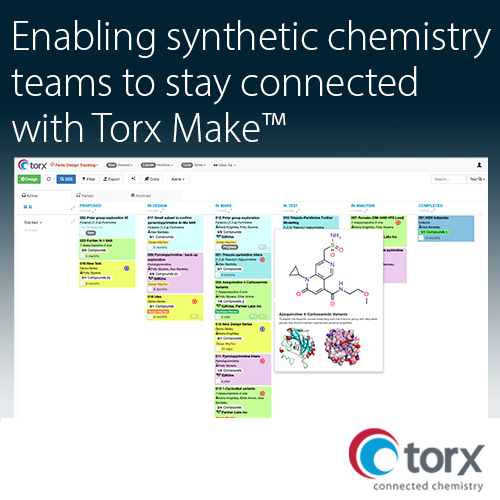Enabling synthetic chemistry teams to stay connected with Torx Make™

The importance of communication in drug discovery
Every drug discovery program can be described using the iterative Design-Make-Test-Analyze (DMTA) workflow. Good communication between all stages of the workflow decreases cycle time and enhances productivity and efficiency. For synthesis in particular, this means being able to share and access the latest project information to co-ordinate the allocation of work and provide synthetic chemists with an understanding of compound priorities in order to plan their schedules accordingly.
A number of factors can make effective communication and resource management a challenge:
- More tools and processes than ever at your disposal to solve drug discovery challenges. As a result, output data has become increasingly complex, and can be difficult to store and manage efficiently.
- The rising trend in pharma acquisitions and outsourcing means that projects now typically involve multiple teams distributed around the globe. Diverse business models can add further complexities, as companies may want to restrict the level of information they share with each collaborator.
- Often multiple communications channels are used simultaneously including emails, phone calls and presentations. It is not a guarantee that key information is delivered to the right people in a timely manner. Nor is it guaranteed that the information disseminated is readily retrieved.
- Progress meetings can carry significant overhead in terms of planning, preparation and implementation. Furthermore, face-to-face meetings are currently restricted due to COVID-19 induced disruptions and may not return in the near future.
Therefore, a holistic approach to workflow management is needed to ensure your drug discovery project progress is not hampered by poor communication. Torx™ was developed to address this point exactly. The platform connects the integral parts of the DMTA workflow to facilitate information delivery throughout the iterative cycle leading to the identification of a new drug.
Torx Make tracks compound synthesis from start to finish
Torx Make focuses on the synthesis step of drug discovery. The web-based solution enables you to track and manage the status of any project compound within seconds. Capturing and sharing information in this way allows chemistry teams to stay connected without the need for resource-intensive progress meetings. It facilitates:
- Capture of design hypotheses and ideas
- Prosecution of compounds for synthesis
- Management of internal and external resources
- Visualization of tracked information for KPIs
- Full configuration of access and privacy permissions for invited users
Manage project updates instantly with a user-friendly ticket system
In each project dashboard, design tracking provides a top-level, visual overview of the progress of ideas across all stages of your DMTA workflow. Design tickets can be simply dragged and dropped along the workflow and updates are observed by all users in real time. The contextual information stored within each ticket is fully configurable.
Compound tracking displays the progress of all compounds that have been passed on from the design step and selected for synthesis. New compounds can be added by using a variety of embedded sketcher options and/or external drawing packages, uploading SMILES strings or SDF files, or transferring seamlessly from Torx Design™. Each new compound can be assigned with priorities to a specific chemist. This way, everyone in your group is clear on their own workload and this avoids any duplication of efforts.
The information fields held within each ticket can be configured to meet users’ exact needs, including physical and chemical properties of each compound and any synthesis requirements. The information held within fields can be edited at any stage and all updates are visible to others working on the project in real time. Visual alerts are used to highlight new updates in the compound tracking layer, to make it easy to monitor project progression. Email alerts can be set up to automatically inform chemists of assignments and other communications through comments and attachments. Compound status changes are referred to the design level ticket and show observable synthesis progress in an instant.
Window views can be customized to display all relevant information. Tickets can be prioritized and filtered by key criteria including synthesis progress, compound type, priority and assigned owner. Each view can be bookmarked to ensure quick access at any time.
Share information securely with external organizations
Torx Make supports secure information sharing with external partners. Permissions and access can be custom set to each organization. Collaboration owners can view design and compound tracking from the perspective of any invited external partner to verify the visibility of designs, compounds and associated metadata, thus ensuring what is (and isn’t!) shared with each partner.
Effective progress reporting to meet business needs
Pharmaceutical and biotechnology companies need to recognize if and where they are making progress, by knowing key information such as average DMTA cycle time or the time taken to meet a specific objective, which is often not easy to locate quickly. Changes made in Torx Make are tracked and can be exported as a holistic report. This information is extremely valuable and can be used to influence strategic decisions to streamline operations. Information added at the conclusion of the design process can be captured for posterity and contribute to corporate learning and ultimately reduced attrition.
Try Torx Make on your project
Request an evaluation to see how Torx Make can be integrated into your small molecule discovery project.





















